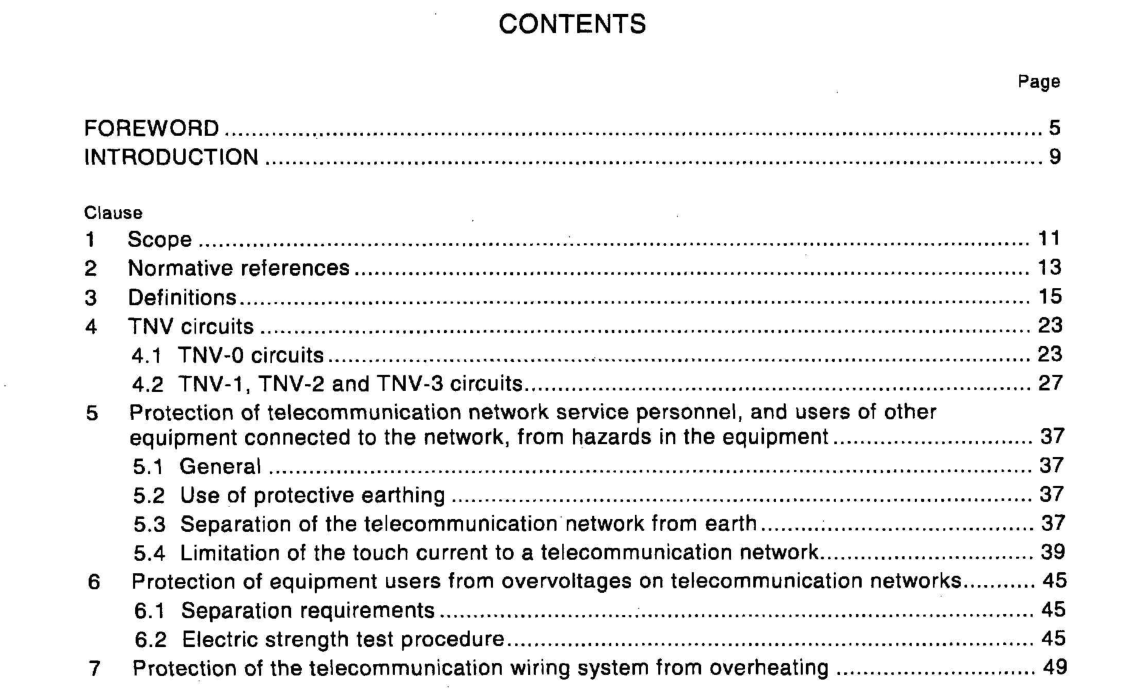IEC 62151 pdf download

IEC 62151 pdf download.SAFETY OF EQUIPMENT ELECTRICALLY CONNECTED TO ATELECO MMUNICATION NET WORK
1 Scope
1.1 Equipment covered by this standard
This International Standard is applicable to equipment designed and intended to be connected directly to a TELECOMMUNICATION NETWORK, regardless of the source of power. It is intended for the enhancement of product safety standards so as to cover hazards associated only with connection of equipment to a TELECOMMUNICATION NETWORK. This standard covers safety requirements and compliance criteria under three headings: . a) protection of SERVICE PERSONNEL working on the TELECOMMUNICATION NETWORK and other USERS of the TELECOMMUNICATION NETWORK, from hazardous conditions on the TELECOM- MUNICATION NETWORK resulting from the connection of the equipment; b) protection of equipment USERS and equipment SERVICE PERSONNEL from voltages on the TELECOMMUNICATION NETWORK; c) protection of the telecommunication wiring system from overheating. It is assumed that adequate measures according to ITU-T Recommendation K.11 have been taken to reduce the likelihood that the overvoltages presented to the equipment exceed 1,5 kV peak. In installations where overvoltages presented to the equipment may exceed 1 ,5 kV peak, additional measures such as surge suppression may be necessary.
1.2 Additional requirements
Requirements additional to those specified in this standard may be necessary for: 一 equipment intended for operation in special environments, for example, extremes of temperature; excessive dust, moisture, or vibration; flammable gases; and corrosive or explosive atmospheres; 一 electromedical applications with physical connections to the patient.
1.3 Exclusions
This standard does not apply to: – protection of equipment USERS and equipment SERVICE PERSONNEL from hazards arising in the equipment. The USER and equipment SERVICE PERSONNEL are considered to be protected from hazards arising in the equipment if it complies with a relevant safety standard; functional reliability of equipment and TELECOMMUNICATION NETWORKS; equipment using a TELECOMMUNICATION NETWORK voltage in excess of the limits for a TNV CIRCUIT.
3 Definitions
For the purpose of this International Standard, the following definitions apply. 3.1 Fundamental concepts 3.1.1 hazardous-live-part live-part which, under certain conditions, can give a harmful electric shock [|EV 195-06-05] 3.1.2 touch current electric current through a human body when it touches one or more ACCESSIBLE parts [IEV 195-05-21 modified] NOTE TOUCH CURRENT was previously included in the term “leakage current”. 3.1.3 telecommunication network a metallically terminated transmission medium intended for communication between equipments that may be located in separate buildings, excluding: – the mains systems for supply, transmission and distribution of electrical power, if used as a telecommunication transmission medium; – television distribution systems using cable. NOTE 1 The term TELECOMMUNICATION NETWORK is defined in terms of its functionality, not its electrical characteristics. A TELECOMMUNICATION NETWORK is not itself defined as being a TNV CIRCUIT. Only the circuits ir equipment are so classified. NOTE 2 A TELECOMMUNICATION NETWORK may be publicly or privately owned; – subject to transient overvoltages due to atmospheric discharges and faults in power distribution systems; subject to permanent longitudinal (common mode) voltages induced from nearby power lines or electric traction lines. 3.2.4 reinforced insulation insulation of HAZARDOUS-LIVE-PARTS which provides a degree of protection against electric shock equivalent to DOUBL E INSULATION NOTE REINFORCED INSULATION may comprise several layers which cannot be tested singly as BASIC INSULATION or SUPPLEMENTARY INSULATION. [IEV 195-06-09] 3.2.5 functional insulation insulation that is necessary only for the correct functioning of the equipment NOTE FUNCTIONAL INSULATION by definition does not protect against electric shock. It may, however, reduce the likelihood of ignition and fire. 3.3 Equipment electrical ratings 3.3.1 rated voltage the supply voltage (for three-phase a.c. supply, the line-to-line voltage) as declared by the manufacturer 3.3.2 rated voltage range the supply voltage range as declared by the manufacturer, expressed by its lower and upper RATED VOLTAGES









